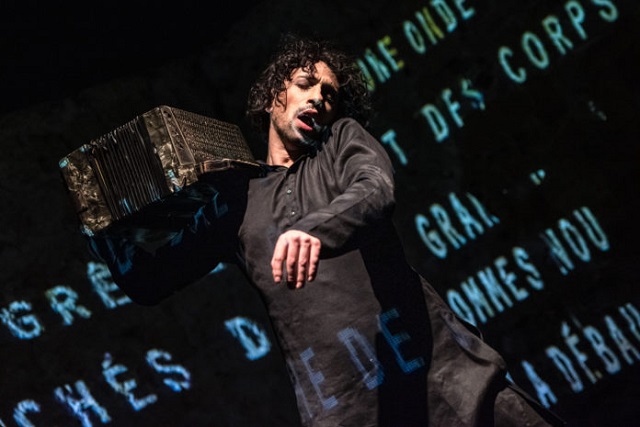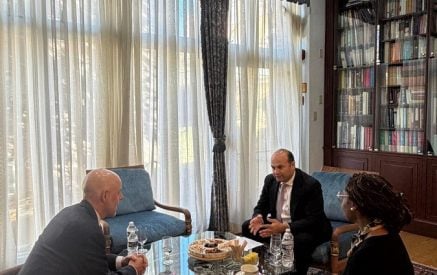The Armenian Mirror-Spectator. Performance: most people in Armenia equate the word solely with theater and ballet. For mime, choreographer and movement guru Vahram Zaryan, this status quo some thirty years after the collapse of the USSR was unacceptable. Sure, the Armenian public has been exposed to contemporary dance through touring companies like the UK’s Akram Khan Dance Company, but this has made little difference in its overall artistic consciousness. Zaryan’s solution? To create a city-specific movement and performance festival — a global first — and choose Paris and Yerevan as the first two twinned cities.
Born in Armenia and now a French resident, perhaps like Charles Aznavour and other French Armenians before him, Zaryan is both completely French and completely Armenian. Hence the choice of first cities was obvious: thus Paris-Yerevan PERF’ was born. Each year, Zaryan will pick a new city to highlight. The idea is always to share and exchange new dance and movement pieces, as well as ideas and texts about performance. Another unique aspect of the festivals: all texts will be translated, so as to assure complete intellectual transparency and to also foreground the art of translation itself. Not one to be easily daunted, when COVID-19 hit, Zaryan took the festival on line. Then the war happened. More about that later.
For the first edition of the festival Zaryan has put together an eclectic program that includes French comedian and director Astrid Bayiha’s “Mamiwata”; interpretations by renowned pianist Maroussia Gentet of composers Philippe Schoeller and Hèctor Parra, and a new work by mime Cécile Ghrenassia. Armenian contributions include director Arturo Sayan’s homage to Sergei Parajanov and Arthur Makaryan’s immersive online improvisational show “The O’Leary Theory.” Zaryan will himself perform “Oblique Cycle 2,” a collaboration with the composer Vincent Trollet and L‘Ensemble Regards, based on poems by Frédéric Parcheminier which casts a look at things disorienting and skewed–hence the title. Apart from spotlighting Yerevan itself, the festival hopes to contribute to Armenian culture by creating a space where people from around the world will exchange ideas, research and work while encouraging multimedia and multidisciplinary work that doesn’t limit creative workers to one specific genre or medium.
As for Zaryan’s Armenian roots, they run deep. His Armenity as he calls it, lies in the Lori region of Armenia where he grew up in the village of Shirakamut, Nalband. Zaryan studied in Vanadzor at the Abelyan Theater and then at the National Theater Conservatory in Yerevan. He then decided to take a proverbial path less trodden in order to study mime at the Armenian State Mime Theater with Zhirayr Dadasyan. Perhaps seeking a larger stage to practice his art form, Zaryan then moved to Paris where he has now spent the greater part of his adult life. There he studied with several leaders of the art form including the legendary Marcel Marceau and has since then moved on to be a leader in the field as the inventor of a new genre called “Non-Mime.”
Read also
In his work, he has fused elements of French culture, itself a heterogenoeus construct, with his own native Armenian one and created something original in the process. As for the festival itself, Zaryan credits the Armenian Diaspora’s spirit of openness and creativity with bringing something truly unique to the endeavor. Paris-Yerevan PERF’ will also give him a much anticipated opportunity to renew his creative links with his homeland: “I have always felt tied to Armenia. My artistic sensibilities themselves were born in my native village, along with me! Armenia is a constant and inexhaustible source of inspiration: its culture is vibrant and important, essential even,” says the choreographer.
In works such as “Mater Replik,” a palpable sense of exile can be felt, or perhaps more accurately an examination of the notion of exile. Explains Zaryan: “The body in exile is not only a notion for those who feel exiled or living outside their own culture — the body itself is a locus of exile — the idea that we are all in the end exiled.” Or fallen perhaps, as in the Book of Genesis? For Zaryan travel, departure, exile are all part of the human experience or Odyssey: “Every human being feels this sentiment at some point in his life, I think…And the idea of return is often key to one’s survival and to enduring both the existential and physical that pain one experiences on a daily basis.”
Zaryan is quick to note that traditional Armenian dance is one of the most ancient known to man: “One finds representations of dance in the Armenian highlands painted as far back as the 5th to 3rd century B.C. Movses Khorenatsi himself heard of the way in which the children of Aram — that is to say Armenians — evoked these dances and accompanying songs in ballads that were accompanied by the lyre. We continue to be proud of and preserve traditional Armenian dance throughout the world, to this very day!”
As for classical dance or ballet, this arrived in Armenia from Russia. ”What is missing is contemporary dance, both in performances and in dance schools which is a shame. Hence one of the festival’s goals is to hold master classes and put Armenian choreographers in contact with well-known choreographers abroad. We also need to establish scholarships so that young Armenian dancers can study abroad.”
In the meantime, the arts are now converging, especially with the presence of big screen projections and the like: the point is to create new work that is vibrant, and not limit yourself to one type or genre… A work that I created this year called Géoïde for example, is multi/pluri-disciplinary, built around a pianist Maroussia Gentet, who co-created the piece with me and a mime-performer (myself) that also brings together circus arts, and the talented singer Marie Soubestre, violinist Apolline Kirklar, accordion maestros Fanny Vicens and Jean-Etienne Sotty, and last but not least video artist Auguste Dia. The music itself is by contemporary composers such as Hector Parrà, Philippe Schoeller and Maël Bailly. It is also not site-specific, we travel the work.”
And through all this whirlwind of creativity, Zaryan’s heart remains inevitably tied to Armenia itself: “We’ve experienced the terrible shock of war once again,” he says with a sigh. Let’s hope that Yerevan PERF’ will spur others in Armenia and the surrounding region forward, and that it helps to build bridges in the Caucasus and around the world.
Main caption: Vahram Zaryan, Non-Mime performance. “Oblique Cycle 1” (photo © Rémy Grandroque)




























































